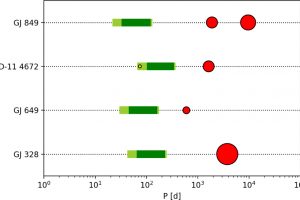On the fequency of sub-neptunians in planetary systems with giant planets. The study: “The GAPS programme at TNG. XLVI. Deep search for low-mass planets in late-dwarf systems hosting cold Jupiters” of M. Pinamonti (INAF – OATo) appeared on A&A

The two giant planets of the Solar System, Jupiter and Saturn, played an important role in shaping the properties and architecture of the inner solar system. This may be a quite general rule. The presence of giant planets, for instance, can be responsible for a less effective migration of solids and gas toward the inner part of planetary systems, inhibiting the in-situ formation of sub-Neptunian planets. The gravitational barrier created by gas giants can also halt the inward migration of sub-Neptunian planets formed in the outer part of planetary systems. On the other hand, the formation of gas giants should primarily occur in very massive protoplanetary disks, where the formation of sub-Neptunian planets should be more likely. Therefore, it is not yet clear how giant planets influence the formation of sub-Neptunian planets in planetary systems.
To comprehend the influence of giant planets on the formation of sub-Neptunian planets, it is essential to conduct an extensive analysis of statistically significant samples of stars hosting gas giants. This is now achievable thanks to the GAPS (Global Architecture of Planetary Systems) project, aimed at understanding the architecture of known exoplanetary systems. The project primarily relies on long series of observations obtained using the HARPS-N spectrograph, installed on the Telescopio Nazionale Galileo.
The team of researchers led by M. Pinamonti (INAF – Astrophysical Observatory of Turin) analyzed the GAPS observations of stars hosting gas giants to search for the presence of sub-Neptunian planets. The stars in question are GJ 328 (an M0 star located 66 light-years away from the Sun), GJ 649 (an M1 star at a distance of 33 light-years), and GJ 849 (an M3.5 star situated 30 light-years away). The observations, spanning time intervals of 1132, 917, and 944 days, respectively, allowed astronomers to identify a sub-Neptunian planet orbiting GJ 328. This exoplanet has a minimum mass of 21.4 Earth masses and an orbital period of approximately 242 days. Additionally, using a statistical approach, astronomers estimated the frequency of sub-Neptunian planets in systems hosting gas giants to be around 25%. Despite the significant uncertainty, this probability is lower than that found in solar-type stars. This suggests that the mass of the central star is an important parameter in determining the influence of gas giants on the formation of sub-Neptunian planets in planetary systems. The study is described in the paper titled “The GAPS programme at TNG. XLVI. Deep search for low-mass planets in late-dwarf systems hosting cold Jupiters” recently published in Astronomy & Astrophysics. Among the coauthors of the study are the astronomers L. Affer, S. Benatti, J. Maldonado, A. Maggio, and G. Micela from INAF – Astronomical Observatory of Palermo.
The figure (click here to view it in its entirety) depicts the configuration of the planetary systems examined in this study, along with the star BD-114672, which hosts both a sub-Neptunian and a gas giant planet. The yellow circles denote the positions of the sub-Neptunian planets, while the red circles represent the gas giants. The green strip indicates the projected boundaries of the habitable zone around these stars.
Mario Giuseppe Guarcello ( follow mariospiegacose) ( mariospiegacose) ( follow mariospiegacose)
Follow the Astronomical Observatory of Palermo on Facebok and on Instagram
Subscribe the Youtube channel of the Astronomical Observatory of Palermo
